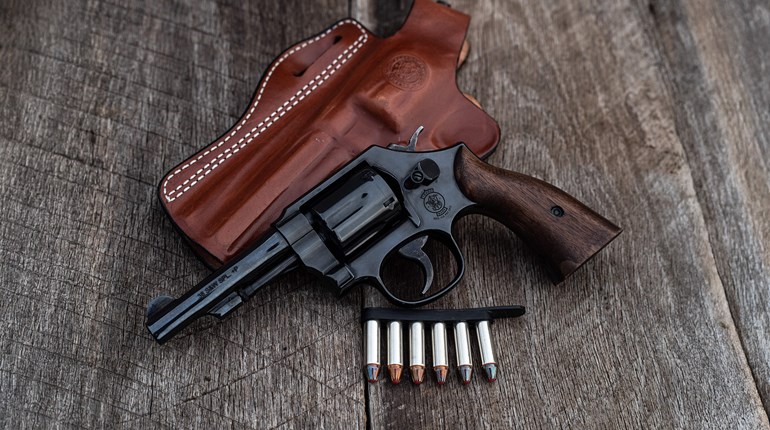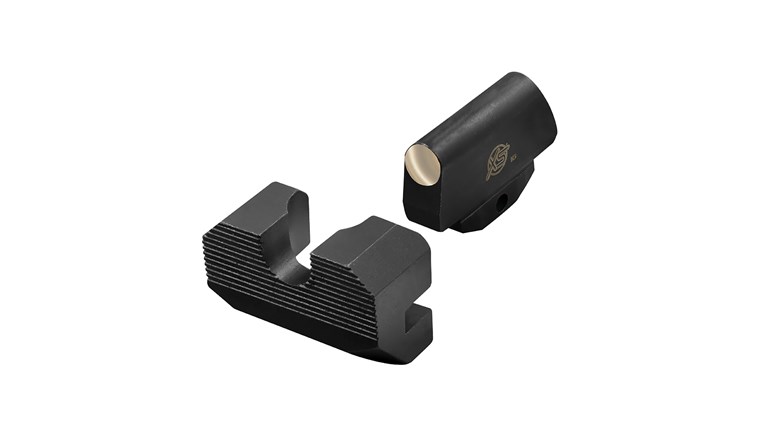
Over the last couple of years, Ruger has done just about everything right with its LCR family of revolvers, and the level of excellence and practical thinking continues with the company’s latest “pocket rocket” chambered in .327 Fed. Mag. This newest hammerless “snubby” sports the standard 1 7⁄8-inch barrel and weighs 17 ounces. The weight gain of 3.5 ounces over the LCR chambered in .38 Spl. results from using a stainless steel frame rather than the aluminum-alloy frame of the .38 Spl, but the fluted cylinder helps keep weight to a minimum. For those who may not know, the .327 Fed. Mag. operates at pressures around 45,000 psi as opposed to 17,000 to 20,000 psi of the .38 Spl. The resulting upgrade in performance is enormous with .327 Fed. Mag. ammo providing 1,400 fps using the lighter bullets and more than 1,100 fps with the heavier weights. The other bonus is the LCR .327 Fed. Mag. holds six rounds rather than the usual five typical of small-frame revolvers.

The front-sight blade is extremely functional. In dim light and close quarters (typical of many hostile encounters), the blade’s white stripe immediately draws your attention. No need for precise alignment and judging light intensity; raise the gun in line with your eyes and the threat, center the front sight’s white line on your assailant and press the trigger. In brighter conditions, the sights allow for some reasonably precise shooting at longer ranges. Offhand groups at 15 yards in daylight ranged from 2.5 inches to slightly larger than 4 inches with both .327 Fed. Mag. and .32 H&R Mag. ammo. Ruger’s friction-reducing cam facilitates good double-action accuracy by making the trigger pull incredibly smooth and consistent throughout the stroke. The trigger design is one of the Ruger LCR family’s great attributes.
The .327 Fed. Mag. does not produce objectionable recoil, but if you’re not a fan of Isaac Newton’s second law about action and reaction, the small revolver shoots .32 S&W and .32 H&R Mag. ammo, too. Still, there’s no free lunch; while the .327’s recoil is easily managed, this high-pressure round is extremely loud. Fired without hearing protection in an enclosed room, it’s likely the .327 will shut down any further audible communications for a while. And although the .32 H&R Mag. ammo offers a good overall compromise between noise and performance, it also will ring your inner-ear bells.

The Hogue Tamer grips with the double finger grooves are also a good feature. The grooves ensure a powerful hold by the two middle fingers of the shooting hand while the grip is long enough to allow some bottom pressure from the pinky finger. The pebbled, tacky-rubber surface provides a no-slip grip for quick recovery between shots. If you wear the gun in a belt holster covered by an outer garment, you might opt for a less “sticky” surface texture to prevent snagging the outer garment during your draw stroke or “printing” the pistol by snagging the coat during normal movements. It’s a non-issue in pocket carry mode as the shooting hand covers the grip before you begin to draw the pistol. Interestingly, disassembly of the pistol requires simply removing the Monogrip.

There are a couple features that might concern you. In the “Don’t worry” category, the pistol rattles when you shake it. That’s the transfer bar, which is intentionally loose. The transfer bar prevents the gun from firing unless the trigger is pulled all the way to the rear of the trigger guard. The second issue does concern anyone using the gun for self-defense. The .327 Fed. Mag. case is rather long for such a small revolver. As a result, the cases do not clear the cylinder when the ejector rod is fully pressed. Reloads must be executed properly. After opening the cylinder, point the muzzle up and tap the ejector rod briskly, allowing gravity to help the cases fall clear of the cylinder. If you want the full power of the .327 Fed. Mag., you need the benefit that comes with its longer cartridge case. So, learn to run the gun proficiently, including the aforementioned reloading technique.
The Ruger manual warns about that dastardly duo, recoil and inertia. In a light-weight pistol using heavier bullets, recoil gives the revolver a sharp push to the rear, while inertia urges the bullet to remain where it was. If the bullet slides far enough out of the cartridge case that it protrudes from the cylinder, it will block the cylinder from rotating into line with the barrel, and you’re done shooting. I have experienced this phenomenon in extremely lightweight .38 Spl. loads with aluminum-case ammo and in big-bore pistols with heavy ammo, but not with the .327 Fed. Mag.
This is a well designed pocket pistol that’s exceptionally useful, particularly for shooters who are sensitive to recoil.





































